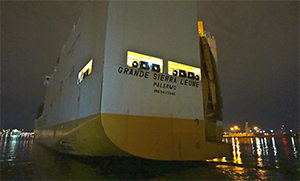From the wheelhouse of the single-screw Kaleen McAllister, Capt. Byshe Hicks watched as the giant con-ro got underway from a Baltimore Harbor terminal.
The pilot aboard Grande Sierra Leone, Bruce Morse-Ellington, ordered Kaleen amidships while the ship’s powerful thrusters pushed the bow away from the terminal. The 102-foot Kaleen idled against the hull and waited for the pilot’s next command.
“OK, Kaleen, you can stop, back away and just hang out on the port-side midships area,” Morse-Ellington, with the Association of Maryland Pilots, said over radio. Hicks confirmed the order and pushed the tug backward using its single z-drive.
This was a straightforward job for Hicks and deck hand Todd Sauerwald, both of whom joined McAllister about three years ago. The night before, the pair docked the 695-foot Italian-flagged Grande Sierra Leone into Dundalk’s Pier 13. Now Kaleen’s job was to escort the ship to a terminal across the harbor. For the early part of the voyage, the tug remained against the ship’s hull, riding alongside the massive vessel.
“This ship is maneuvering fine so he is not even calling us up to the bow,” Hicks said as Grande Sierra Leone chugged toward the main channel. “A lot of times we are basically insurance. We are there to make sure nothing goes wrong.”
The 3,300-hp Kaleen McAllister left the company’s Locust Point pier at about 2300 on Feb. 27, shortly after McAllister’s two other Baltimore tugs, the 5,100-hp Bridget McAllister and 4,000-hp Timothy McAllister, departed to assist a ship at a nearby coal terminal.
With jazz playing softly in the background, Hicks guided Kaleen around Locust Point past Fort McHenry, which British ships attacked over two days in September 1814 during the War of 1812. Francis Scott Key witnessed the bombardment and the fort’s survival, and the poem he wrote later became “The Star-Spangled Banner.”
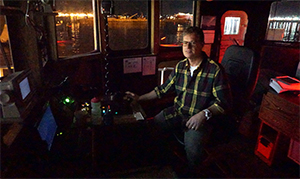 |
|
In the tug’s wheelhouse, Capt. Byshe Hicks waits for a command from the ship’s pilot as it prepares to depart Dundalk’s Pier 13. |
Hicks pointed Kaleen southwest in the Patapsco River toward the Francis Scott Key Bridge, which marks the harbor’s edge. About this time, he handed the controls to Sauerwald, who holds a 200-ton license and is pursuing his 500-ton credential. Kaleen was making about 8.8 knots — just under the 9-knot harbor speed limit — when a flock of Canada geese arose from the water just in front of the tug. Otherwise, it was an uneventful leg.
Kaleen was one of the few vessels underway. The container port at Seagirt Marine Terminal, with its massive white post-Panamax cranes, was quiet. Across Colgate Creek, vehicles, farm machinery, construction equipment and other rolling cargo sat neatly in rows awaiting their next move at Dundalk Marine Terminal.
Baltimore has one of the busiest ports in the country, with active container and ro-ro terminals and dry-bulk facilities that handle grain, coal, sugar, paper, wood products and countless other materials. Maryland Port Administration data shows 10.1 million tons of cargo moved through Baltimore’s public terminals in 2016, a 5 percent increase and a new record. Data shows those terminals are off to a strong start in 2017, with volumes up more than 12 percent compared with January 2016.
Those figures do not include private terminals around the harbor that moved additional cargoes, according to a port spokesman.
Despite its activity, Baltimore Harbor is a relatively comfortable place to work. The harbor itself is relatively small and the Patapsco River has little current and minor tidal swings, although wind can be a challenge. It also can get hectic in the late afternoon and early morning when the largest ships tend to come and go.
“When everyone is trying to leave at once or is coming at once, it’s kind of like a traffic jam,” Hicks said. “There are some piers that are challenging. The Fort McHenry pier that we have, it’s a skinny slip and you don’t have much room for the tugs.”
McAllister’s tugs split most of the ship docking jobs with Moran Towing and another small operator, said Mike Reagoso, vice president and general manager for McAllister Towing of Baltimore. The company employs about 20 people who work two-and-two turns, meaning two weeks on, then two weeks off. Much of the docking and assist work in Baltimore happens between 1500 and 0600 hours.
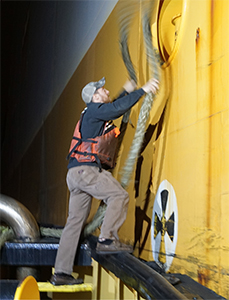 |
|
Deck hand Todd Sauerwald attaches a line from Kaleen McAllister to a hull chock on Grande Sierra Leone. Sauerwald has a 200-ton license and is working toward his 500-ton credential. |
Grande Sierra Leone, operated by Grimaldi Lines, was almost ready to transit when Kaleen rounded the point at the Dundalk terminal at 2120. About 10 minutes later, the ship was underway. It has a wide, boxy stern for ro-ro cargo and an open foredeck for cargo containers. The forward hull has a sharp flare leading to a bulbous bow.
The con-ro cleared the terminal and turned to starboard, cutting across an anchorage en route to the 50-foot-deep main channel. The ship was drawing 31 feet, leaving plenty of room between it and the harbor’s soft bottom.
During the next 15 minutes, Morse-Ellington spoke several times with the pilot aboard the 958-foot bulker KSL Santiago, which took a load of coal at Baltimore’s CNX Marine Terminal. McAllister’s two other tugs, Bridget and Timothy, were alongside to swing the ship’s bow around for outbound transit.
“OK man, we’re dropping lines. I guess we’ll slowly work our way out and let you get through there,” Santiago’s pilot said to his counterpart.
“All right, yeah, we’re rolling here. We won’t hold you up too long,” Morse-Ellington responded.
Kaleen stayed alongside the port-side hull as Grande Sierra Leone accelerated to 12.5 knots in the main channel. Red and green channel lights, one at Fort McHenry, the other atop Under Armour’s headquarters, marked the vessels’ position safely within the boundaries. The Dundalk terminal is about three miles southeast of South Locust Point 12, the ship’s destination in a section of the harbor known as the Ferry Bar Channel, and the vessels covered the distance quickly.
“Kaleen, can I get you to hop on over to the starboard side?” the pilot asked as the vessels approached a slight turn into the channel.
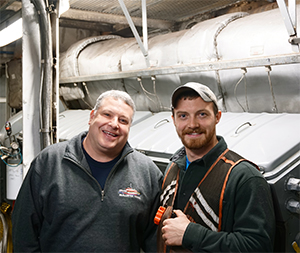 |
|
Mike Reagoso, vice president and general manager for McAllister Towing of Baltimore, stands with Sauerwald during a tour of the tug’s spacious engine room and machinery spaces. |
“Where do you want me? Amidships again?” Hicks responded.
“Yeah, that should do for a while. She doesn’t turn so hot to starboard, so I will probably need you to shift the quarter around when we reach the turn into the channel there,” Morse-Ellington said.
Hicks, who retook Kaleen’s controls before the ship left the terminal, acknowledged the pilot’s order and spun the tug counterclockwise. As the ship moved ahead, Hicks went around the stern and took a position alongside the starboard hull awaiting the next order.
Kaleen is a former Navy YTB tugboat — Pontiac, built by Southern Shipbuilding in 1961. McAllister acquired it in 2000 and two years later installed an EMD 16-645-E5 turbo engine and a Schottel 1515 CP z-drive. Nine years later, the company installed an EMD 12-710 G7C Tier 2 engine and twin John Deere generators with help from a federal stimulus grant.
McAllister has 11 former YTBs in its roughly 60-vessel fleet, and nine have been converted into twin-screw tractor tugs. Donal G. McAllister, which formerly worked in Baltimore but is now in Charleston, S.C., is the company’s other single-screw tractor tug.
Kaleen is known as a forgiving boat with plenty of power for ship docking and assist. It’s nimble and quick thanks to the z-drive.
“You can do things with it you can’t do with a regular single-screw. We can … spin around in our own length, we have really good control going backward — I can drive the boat just as well going backward as I can going forward,” Hicks said.
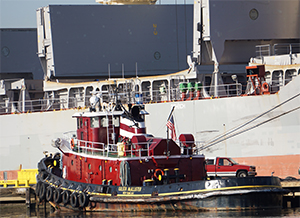 |
|
Kaleen McAllister ties up along the company’s pier at Locust Point after a night’s work in Baltimore Harbor. The Marshall Islands-flagged bulker Amorgos unloads grain in the next slip. |
“What the pilots really like is we can stay on a 90 just by turning the (z-drive) unit 90 degrees,” he continued. “We can be on the 90 and give direct push or pull.”
The tug has a spacious interior originally meant for 11 people. These days, it normally sails with two people, and Reagoso said it mainly works within the harbor. From time to time, Kaleen is dispatched to an oil terminal at Piney Point, Md., about 10 hours south, or Sparrow’s Point just outside the harbor.
Once Kaleen was in position, the pilot ordered it to get a line up on Grande Sierra Leone’s starboard quarter. Hicks eased off on the throttle while the ship continued forward, then spun the tug 180 degrees so its bow faced the ship’s stern. Sauerwald went down to the deck and prepared to attach the line.
Sauerwald pulled the 7-inch Samson Neutron rope through the bow staple and grabbed about 5 feet of line in both hands, forming a U-shape. He swung the rope straight back over his head, then stepped forward and wrapped it around a hull chock. Hicks hauled in the line using the JonRie InterTech Series 200 bow winch to create the proper tension.
With Kaleen’s assistance, the ship’s stern swung modestly starboard near the entrance to Ferry Bar Channel just south of Locust Point. Nearby, KSL Santiago started backing into the main channel with help from the two other McAllister tugs.
Soon, Morse-Ellington ordered Kaleen to haul in its line and for Grande Sierra Leone to get a line out on the port quarter for docking. Hicks crossed behind the stern and Sauerwald reattached the line. Hicks guided the tug toward the ship as it prepared to dock with help from the tug and its thrusters. On the pilot’s command, Hicks pivoted 90 degrees to begin pushing the ship into its berth.
 |
|
His shift over, Capt. Byshe Hicks prepares for the ride home. He commutes to work from his home in Baltimore’s historic Fell’s Point neighborhood by bicycle, even in winter. |
“Come ahead one bell, Kaleen,” Morse-Ellington said, referring to the half-ahead order on the tug’s engine.
Moments later, the pilot asked the lineman on the pier how the ship looked.
“The way she is coming in now, she will be just about in position,” the lineman responded.
“OK, I’ll get her stopped then,” the pilot said before ordering Kaleen to idle.
Moments later, Morse-Ellington ordered Kaleen to stop.
“All stop,” Hicks said.
The pilot checked distances and the lineman suggested moving another 10 meters astern. He ordered Kaleen to idle and then to easy-ahead until the lineman announced the ship was in position.
“All right, Byshe, you can stop and get your line, we are all finished with you,” Morse-Ellington said. “Have a good evening and a good morning.”
Grande Sierra Leone was Kaleen’s only job that night. That was OK with Hicks and Sauerwald, who worked most of the previous night. Hicks guided the tug around Fort McHenry and back into McAllister’s pier on the other side of Locust Point. By 0130, both were heading home, looking forward to a good night’s sleep.

